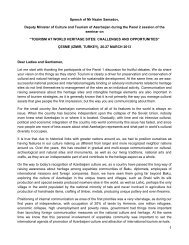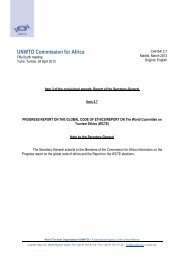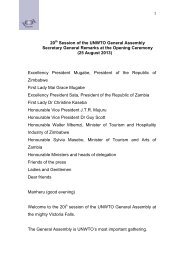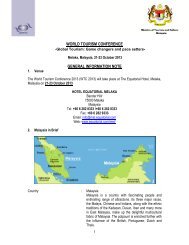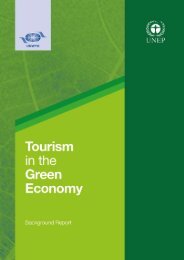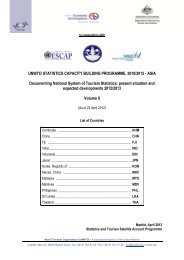Management Strategy for Chi Phat Community-based Ecotourism ...
Management Strategy for Chi Phat Community-based Ecotourism ...
Management Strategy for Chi Phat Community-based Ecotourism ...
You also want an ePaper? Increase the reach of your titles
YUMPU automatically turns print PDFs into web optimized ePapers that Google loves.
MANAGEMENT STRATEGY FOR CHI PHAT<br />
COMMUNITY-BASED ECOTOURISM<br />
DEVELOPMENT AND CONSERVATION<br />
PRESENTED BY:<br />
SUWANNA GAUNTLETT<br />
NOVEMBER 2, 2013
MISSION STATEMENT<br />
Wildlife Alliance is the leader in providing direct protection to<br />
<strong>for</strong>ests and wildlife. Our mission is to combat de<strong>for</strong>estation,<br />
wildlife extinction, climate change and poverty by partnering<br />
with local communities and governments.<br />
Why Cambodia?<br />
Wildlife Alliance has focused its conservation programs on the Indo-<br />
Burma “biodiversity hotspot” since 1997, in Myanmar (Alaungdaw<br />
Kathapa National Park), in Thailand (Kao Yai National Park) and in<br />
Cambodia (7 National Parks of Bokor, Lumphat, Samlaut, Botum<br />
Sakor, Dong Peng, Peam Krasop and Southern Cardamoms).
Why the Cardamoms?<br />
• Most important <strong>for</strong>est watershed in Cambodia, regulating<br />
rainfall <strong>for</strong> the entire region with 3,500-4,500mm of rain<br />
per year supplying 22 rivers and feeding 3,145 villages<br />
• Cardamom Mountain Range is the second largest<br />
contiguous <strong>for</strong>est in South East Asia.<br />
• One of Asia’s only 7 remaining elephant corridors<br />
• Only habitat on earth <strong>for</strong> Siamese Crocodiles and Royal<br />
Turtles<br />
• One of the planet’s 32 biodiversity hotspots<br />
• An important archeological corridor<br />
• Largest carbon sink in Cambodia
Archeological Corridor
‣ Our challenge when we started in 2002 in the Cardamoms<br />
was to fight a complete chaos of <strong>for</strong>est fires, land grabbing,<br />
slash and burn agriculture and wild animal killings. It looked<br />
like a war zone.<br />
‣ 9 years ago, <strong>Chi</strong> <strong>Phat</strong> rain<strong>for</strong>est was up in flames - <strong>for</strong>est<br />
fires were everywhere - wildlife was being decimated <strong>for</strong><br />
commercial trade to Thailand, Vietnam and Phnom Penh. It<br />
was so extreme, that we called <strong>Chi</strong> <strong>Phat</strong> the “Circle of Death”.<br />
‣ So we started in 2003: we identified that 280 families were<br />
causing this destruction. Why? Because they were the<br />
poorest, landless farmers of the province that owned nothing<br />
- not even a buffalo - and had only the <strong>for</strong>est to survive on.
• We worked with local people and local authorities to turn the<br />
situation around.<br />
• The project was launched in 2007 after extensive consultation and<br />
participatory planning with the community and local authorities.<br />
Of the 280 families who were burning the <strong>for</strong>est and killing<br />
wildlife BEFORE, 245 families have jobs TODAY<br />
• 100 families are earning direct revenues from eco-tourism<br />
• 20 families are earning indirect revenues from eco-tourism<br />
• 75 families are producing vegetables, fruit and livestock<br />
• 50 families are working in the Re<strong>for</strong>estation Nursery
• WA used as guideline the APPA<br />
methodology from the Mountain Institute<br />
that coaches the community to<br />
own, manage and operate its own<br />
ecotourism product.<br />
• We provided on-going training <strong>for</strong><br />
hospitality, eco-guiding, computers,<br />
English and accounting.
WA invested in infrastructure:<br />
• 200 km of <strong>for</strong>est trails and 5 night camps<br />
• 20 mountain bikes<br />
• 8 kayaks<br />
• 13 guesthouses and 11 homestays<br />
• Visitor center with restaurant, tourism booking office, exhibition room<br />
and meeting room<br />
• Retrofitting of 1 large boat, 6 medium boats and 15 rowing boats<br />
• Retrofitting of main road<br />
• Establishment of a waste management service<br />
• “On the job training”<br />
WA invested in manpower:<br />
• 2 permanent WA staff working in <strong>Chi</strong> <strong>Phat</strong> to coach the community<br />
• Start-up financial support in the direction of the management team of<br />
CBET
Our marketing strategy has been from the beginning in 2002 to<br />
promote the entire Southern Cardamoms as an ecotourism<br />
destination.<br />
Promotion to the international tour guides and media (Lonely<br />
Planet, New York Times, The Wall Street Journal, The Sydney<br />
Morning Herald, Le Temps, Le Guide du Routard, Le Petit Futé...)<br />
Agreements with 10 international tour operators and 5 national<br />
Marketing to other hotels and lodges
• Our goal is that the community will protect its own <strong>for</strong>ests and<br />
wildlife.<br />
This requires a 180% change in mindset from raping and pillaging the<br />
<strong>for</strong>est to protecting it as an economic asset. This is a long-term<br />
change that will require many years.<br />
• Where are we today, after only 5 years of CBET?<br />
“If we continue cutting the <strong>for</strong>est, there will be no more <strong>for</strong>est <strong>for</strong> our<br />
children” say people of <strong>Chi</strong> <strong>Phat</strong> today. They have 95% stopped<br />
burning the <strong>for</strong>est <strong>for</strong> slash and burn but they are still hunting and<br />
logging.<br />
• There<strong>for</strong>e, the key to protection is law en<strong>for</strong>cement<br />
The community is starting to agree with and recognizes the value.<br />
Without this law en<strong>for</strong>cement component, the nature assets of ecotourism<br />
(landscape, wildlife) will be soon destroyed.
• The University of Otago’s "Living in the Shadow of Angkor" project is so<br />
named because people tend to encapsulate any culture's history by the<br />
star attractions -- and if Cambodian history is on anyone's radar at all,<br />
then it is all about Angkor.<br />
• But the Living in the Shadow of Angkor project found that a culture was<br />
living in the Cardamoms from about 1395AD and then well into the 17th<br />
century, and certainly at the same time as the decline of the lowland<br />
Kingdom of Angkor in the 14 th and 15 th centuries AD.<br />
- This is a previously unrecorded culture living in remote mountain<br />
jungles.<br />
- They have no connection to Angkor.<br />
- They had a fascinating burial practice unlike any recorded in the time<br />
be<strong>for</strong>e or during the Khmer empire.
This Burial Jar Site explored <strong>for</strong> the first time in<br />
2012 in an expedition led by archeologist, Dr.<br />
Nancy Beaven from OTAGO University, New<br />
Zealand, and the Cambodian Ministry of Culture<br />
and Fine Arts.
We knew that <strong>Chi</strong> <strong>Phat</strong> alone would not be enough<br />
to attract international tourism. We had to protect<br />
the entire province and landscape. This is what<br />
created the conditions <strong>for</strong> international investors to<br />
come in and develop other ecotourism destinations<br />
that are complementary to <strong>Chi</strong> <strong>Phat</strong>.
<strong>Chi</strong> <strong>Phat</strong> is “the ecotourism gateway to one of Southeast<br />
Asia’s largest remaining tracts of rain<strong>for</strong>ests” (Wall Street<br />
Journal)<br />
CARDAMOMS: “Top Ten Regions in the World” <strong>for</strong> Lonely<br />
Planet<br />
CHI PHAT: best <strong>Community</strong>-Based <strong>Ecotourism</strong> in Cambodia<br />
<strong>for</strong> Ministry of Tourism, Lonely Planet, New York Times, Sidney<br />
Morning Herald, The Guardian, Fat Thai In-Flight Magazine
Thank You





